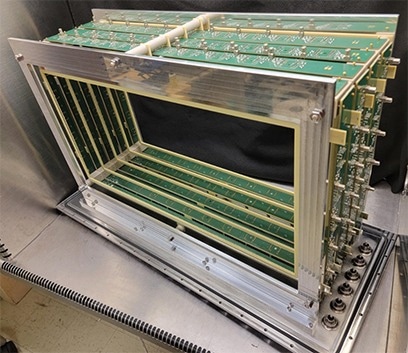At the Facility for Rare Isotope Beams (FRIB), a scientific team has come up with a new optical detector. This progress will allow scientific users to help gain new insights and discoveries in nuclear physics.

Photo of the Energy Loss Optical Scintillation System optical readout assembly (with no photomultiplier tubes) including mechanical supports. Image Credit: Michigan State University Facility for Rare Isotope Beams.
The study’s findings are elaborated in an “Editor’s Pick” paper reported in the journal Review of Scientific Instruments.
The Energy Loss Optical Scintillation System (ELOSS) constitutes progress in both instrumentation and abilities in experimental nuclear physics. The newly-developed detector enables scientists to study isotopes at high performance and a high beam rate.
ELOSS has been assisted by a three-year grant from the National Science Foundation, via the NSF Major Research Instrument (MRI) program.
In experimental physics, innovation and advancements have always been closely linked to improvement in accelerators and colliders technologies.
Marco Cortesi, Leader, Detector Systems Group and ELOSS Project, Facility for Rare Isotope Beams, Michigan State University
Cortesi added, “Modern powerful machines demand the development of innovative detectors capable of taking advantage of the new beam capabilities. FRIB is a new accelerator technology with an impressive discovery potential. Now, we have improved detecting equipment as well to advance and strengthen the ambitious scientific program at FRIB.”
The research group included Cortesi; Alexandra Gade, Professor of Physics at FRIB and in MSU’s Department of Physics and Astronomy and FRIB Deputy Scientific Director; Remco Zegers, Professor of Physics at FRIB and in MSU’s Department of Physics and Astronomy; Jorge Pereira, Research Staff Physicist; Daniel Bazin, Research Professor; Steve Lidia, Beam Instrumentation and Measurements Department Manager; Joe Asciutto, Diagnostics Engineer; and Sean Dziubinski, FRIB Graduate Assistant.
For the past several years, scientists have utilized a traditional ionization chamber to determine the atomic numbers of bulky ions with the help of an energy loss measurement. But the tradition was broken by the FRIB scientists. Rather, they quantified the light produced along the track with their optical ionization chamber present in the focal plane of the S800 spectrograph at FRIB.
The multi-segmented optical detector has been loaded with xenon gas at pressures varying from 400 to 800 Torr. It is a range around the pressure of the atmosphere. Standard tools for light detection, photomultiplier tube arrays, encircle the gas and are positioned together with the direction of the beam for the scintillation light to be recorded.
The number of detected photons present seems to be proportional to the energy that has been deposited by the beam particle together with its track in the efficient detector volume. This enables researchers to determine the corresponding atomic number.
The ELOSS technique provides numerous technical benefits over traditional charge readout systems. The team discovered that ELOSS has the potential to quantify the energy loss of heavy ions with almost three times better resolution and at ten times the counting rate, or the speed at which measurements could be taken.
This saves time by enabling faster experiments and empowering researchers to collect more statistics at a quicker pace. It unlocks opportunities for new experiments as well.
Marco Cortesi, Leader, Detector Systems Group and ELOSS Project, Facility for Rare Isotope Beams, Michigan State University
In the measures taken, a notable role was played by Dziubinski, a physics doctoral student, Dziubinski also fabricated a tabletop technique for calibration to be executed, which Cortesi remarked as vital to the success of the project.
Dziubinski stated, “I’ve been building and running experiments the entire time I’ve been at Working on the ELOSS project has provided me with constant exposure to new tools and concepts in physics.”
Cortesi states that the involvement of student researchers like Dziubinski as vital to the field’s long-lasting progress. In offering training for a new generation in detector research and development, Dziubinski stated scientists could better exploit the power of FRIB’s accelerator technology and track cutting-edge physics with higher vigor and efficiency.
ELOSS is an upgrade to improve particle identification, and there is more coming. We want to take advantage of the opportunities FRIB offers. We can do that with this new detector.
Marco Cortesi, Leader, Detector Systems Group and ELOSS Project, Facility for Rare Isotope Beams, Michigan State University
This work was financially supported by the NSF-MRI under grant # PHY-2017986.
Journal Reference:
Cortesi, M., et al. (2022) Design and construction of a novel energy-loss optical scintillation system (ELOSS) for heavy‐ion particle identification editors-pick. Review of Scientific Instruments. doi.org/10.1063/5.0124846.